These appliances look modern and inexpensive. They are capable when properly installed and operated long time fulfill their functions. In order to fully use all the potential possibilities, it is necessary to accurately calculate the power of the aluminum radiator, which will be required for high-quality heating of housing in the most difficult weather conditions.
Design and technical features
Quality products from this metal are created using casting. This makes it possible to manufacture solid, durable heating devices, in which there are no individual elements, their connections. This technology difficult enough. To exclude the appearance of defects, exact observance of many production regimes is required, control of the absence of hidden defects, cavities. The cost of such radiators is slightly higher than that of prefabricated models. But it is they who can withstand a large increase in pressure in the coolant supply lines without damage.
The second common technique is extrusion. Pressurized metal fills a special mold. The workpiece is cut into pieces. The individual elements are connected by welding. In this case, relatively inexpensive manufacturing processes are used. But it should be borne in mind that finished goods are less durable and reliable compared to the first option.
Aluminum radiators of the required dimensions are created from separate blocks so that the final power is sufficient for a particular room. Below are the ranges of values \u200b\u200bof the main characteristics of devices of this type:
- Permissible maximum pressure in the heat supply system: from 6 to 24 atm.
- Heat carrier temperature (max.): Up to + 110 ° С.
- Service life of the heating device: 10 to 20 years.
Parameters of one section:
- power - from 0.08 to 0.210 kW;
- the volume of the coolant - from 0.2 to 0.5 liters;
- weight - from 0.9 to 1.5 kg.
How many sections of an aluminum radiator are needed to heat one room
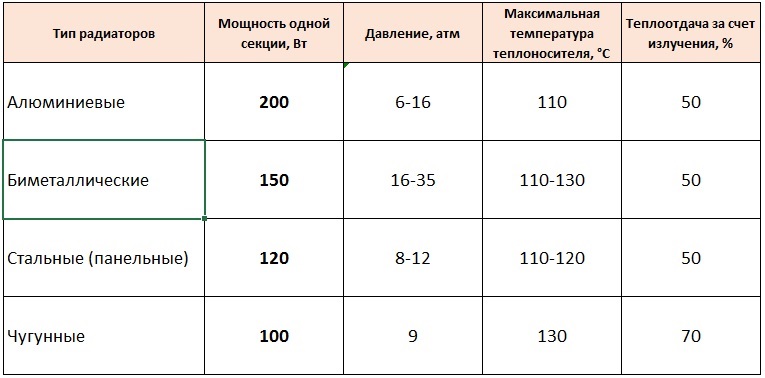
The simplest and, accordingly, not accurate calculation can be made using the following proportion: for every square meter of the room, thermal power not less than 0.1 kW.
To find out how many sections you need, follow these steps:
- For heating one room with an area of \u200b\u200b30 sq. power of 3 kW is required: 30 * 1 \u003d 3.
- If the power of a single element is 0.15 kW, then 20 sections are needed: 3 / 0.15 \u003d 20.
- This amount is too large for one radiator, so it will be necessary to create and install two batteries in the room. Each of them will be composed of 10 sections.
A more accurate result can be obtained by considering the following factors:
- climatic conditions in the area;
- the height of the ceilings;
- the number of window and door openings in the room, external walls;
- the presence of heated floors below and above;
- general insulating characteristics of the structure.
Correction factors are used for each of the parameters. Their values \u200b\u200bcan be found in professional reference books. Substituting them into the general formula, it will not be difficult to find out what power is required in kW of the section and the device as a whole for a particular room. If you get an inaccurate figure, then rounding should be done upward. It is easier to make adjustments when setting up equipment correctly if it is purchased with a certain margin of capabilities.
How to properly mount and operate more profitably aluminum radiators
The main advantages of this type of instrument are not difficult to understand from the above data.
However, we will list them separately:
- The prefabricated structure allows you to fairly accurately select the number of elements so that the heating power is sufficient.
- Low weight facilitates the production of transport and assembly operations. It does not create unnecessary loads on the fasteners and the building structure.
- Small internal volumes and excellent thermal conductivity reduce inertia. This means that it is permissible to combine such devices with individual regulators, as well as integrate them into modern systems automated maintenance of comfortable temperature conditions. Such equipment will reduce the consumption of energy resources during operation.
- The neutral appearance of most models is well suited to a variety of designs.
- The low cost of devices allows you to create new or upgrade old heating systems without high costs.
They are suitable for the simplest one-pipe and the most complex collector circuits. They are suitable for work with gravitational or forced movement of the coolant.
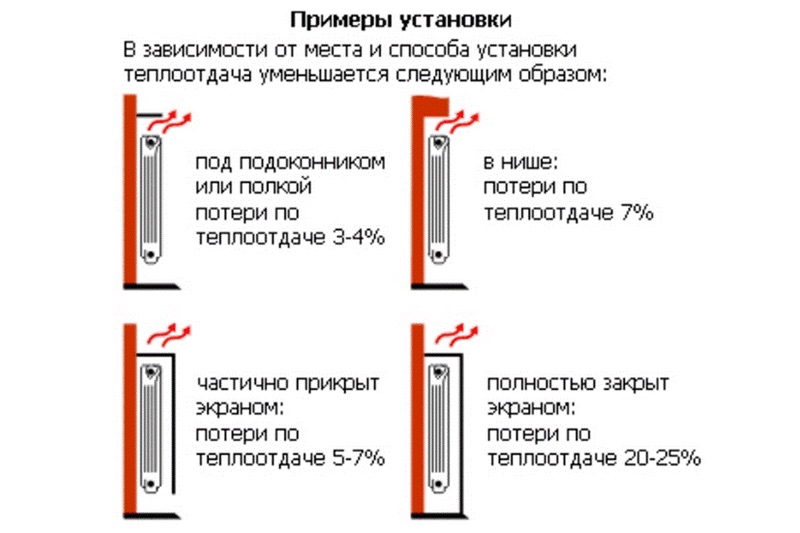
During installation, the following features should be taken into account:
- All devices must be equipped with air release valves.
- Fastening them must be performed in a strictly horizontal position.
- When the pH of the coolant (Ph) goes beyond the range from 7 to 8 units, reactions that destroy aluminum will occur.
- Over time, this metal is covered with a protective oxide film, which will prevent the processes mentioned above. However, it itself can be damaged by sand and other mechanical impurities. Such contamination can be removed using a standard main filter.
- In urban conditions, it is difficult to prevent the occurrence of emergency situations associated with a sharp increase in pressure. It is recommended to install here heating devicesdesigned for high pressure.
Cast iron radiators are radiators that have come down to our time since the distant 70s of the last millennium. Today they are more modern, it is almost impossible to distinguish them from bimetallic or aluminum enamelled radiators. Cast iron radiators are capable of operating with a coolant temperature up to 110 0 C.
Pretty big size and the impressive weight is compensated by the inertia that allows you to regulate the temperature. They are ideal for any room, reliable and durable, can be used with any boilers and heat carriers. Many are interested in the question - how many kilowatts are in one section of a cast-iron radiator? You will find the answer to this question below.
Cast iron heating radiator
Cast iron radiators M-140
Radiators of the M-140 type have quite simple design and easy to maintain. The material used in their manufacture is cast iron. It is highly resistant to corrosive processes and can be used with any heat carrier. The low level of hydraulic pressure allows the use of radiators for both gravitational and forced circulation systems of the coolant. The high threshold for countering hydraulic shocks allows them to be used both in two-story and nine-story buildings. The advantages of the M-140 are ease of maintenance, reliability, long service life and low cost.
Cast iron radiators MS-140-500
They are widely used for heating buildings with a coolant t within 130 0 C and a pressure of 0.9 MPa. The capacity of one cavity is 1.45 liters, the volume of the heated area is 0.244 square meters... The material used for the manufacture of sections is SCH-10 (gray cast iron).
Cast iron radiators MS-140-300
Radiators used to heat rooms with low windowsills and a pressure of 0.9 MPa. The capacity of the cavity is 1.11 liters. The weight of the cavity, taking into account the components, is 5700 g. The calculated heat flux is 0.120 kW.
Cast iron radiators MS-140M-500-09
Radiators of this model are used for different premises with a heat carrier t up to 130 0 С and a pressure of 0.9 MPa. The mass of one cavity is 7100 g. The material used for manufacturing is gray cast iron. S heating with one cavity - 0.244m 2.
Important! When choosing a radiator for housing, be sure to pay attention to its characteristics and make all kinds of calculations in advance, since it will be almost impossible to exchange the purchased goods.
Pros and cons of using cast iron radiators

Stylized cast iron radiator
Any heating system existing today has both pluses and minuses, consider them.
The nominal heat output of each section is 160W. Approximately 65% \u200b\u200bof the released heat flux heats the air accumulating in the upper part of the room, and the remaining 35% heats the lower part of the room.
- Long period of use, ranging from 15 to 50 years.
- High level of resistance to corrosive processes.
- Possibility of using in heating systems with gravitational circulation of the heat carrier.
- Low efficiency of the heat transfer index correction;
- High level of labor intensity during installation;
Important!In order not to face a problem during installation, be sure to take into account the above pros and cons of cast iron radiators. Their installation is not cheap, but repeated assembly work will require a lot of financial resources.
Calculation of sections (cavities) of radiators

And so, how many kW in 1 section of a cast-iron radiator? To calculate the number of sections and their power, you need to decide on the V room, which will later appear in the calculations. Next, we select the value of thermal energy. Its meanings are as follows:
- heating of 1m 3 houses from panels - 0.041kW.
- heating of 1 m 3 of a brick house with double-glazed windows and insulated walls - 0.034 kW.
- heating of 1m 3 of premises erected according to modern building codes - 0.034 kW.
The heat flux of one cavity of the MS 140-500 is 0.160 kW.
Then the following mathematical operations are carried out: the volume of the room is multiplied by the heat flux. The resulting value is divided by the amount of heat released by one cavity. Round the result up and get the required number of sections.
How many kilowatts in cast iron section? Each type of radiator has a different value, which the manufacturer calculates during their manufacture and indicates it in the accompanying documentation.
Let's make an approximate calculation based on the available data.
The room has the following data: type of room - panel house, length - height - width - 5x6x2.7 m, respectively.
- We calculate the volume of the room V:
V \u003d 5 x 6 x 2.7 \u003d 81 m 3
- Required heat volume:
Q \u003d 81 * 0.041 \u003d 3.321 kW
- Based on this, the number of radiator sections is as follows:
n \u003d 3.321 / 0.16 \u003d 20.76
where 0.16 is the thermal power of one section. Specified by the manufacturer.
- We round the value up, based on which the number of required sections is 21 pieces.
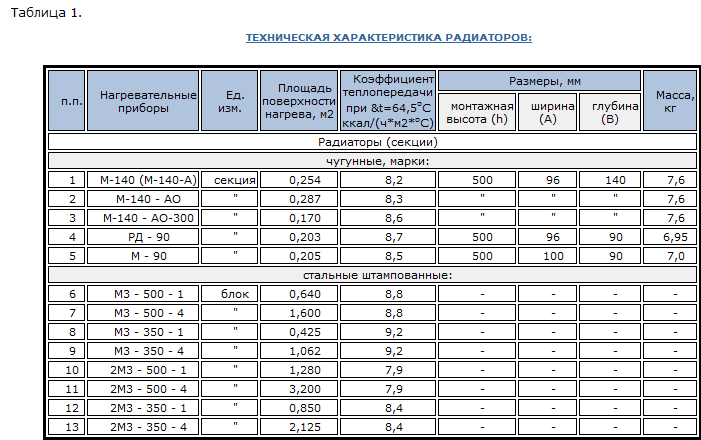
For heating your home to be effective, you should buy high-quality elements. Before that - to carry out the correct calculation of their power.
Calculations are made taking into account:
- room area;
- the height of its ceiling;
- number of windows
- the length of the room;
- features of the climate in the region.
Right choice
- The productivity of heating devices should be 10% of the area of \u200b\u200bthe room if the height of its ceiling is less than 3 m.
- If it is higher, then add 30%.
- For the end room, add another 30%.
Required calculations
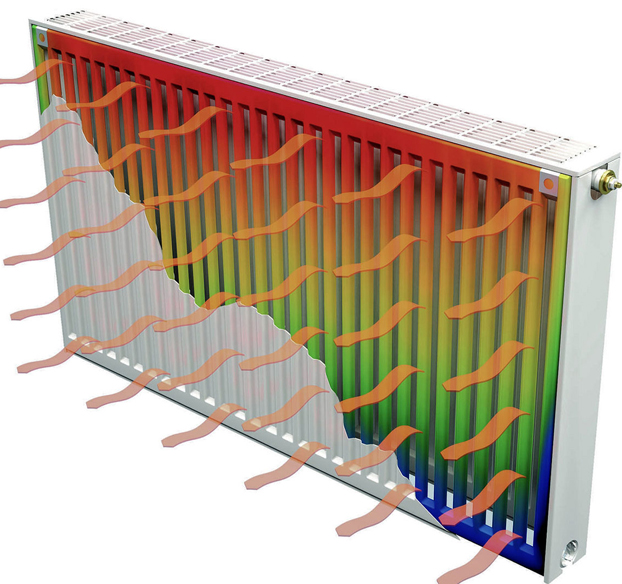
After determining the heat loss, you need to determine the performance of the device (how many kW in a steel radiator or other devices should be).
- For example, you need to heat a room with an area of \u200b\u200b15 m² and a ceiling height of 3 m.
- We find its volume: 15 ∙ 3 \u003d 45 m³.
- The instruction says that for heating 1 m³ in the conditions of Central Russia, 41 W of thermal performance is needed.
- This means that we multiply the volume of the room by this figure: 45 ∙ 41 \u003d 1845 W. A heating radiator should have this power.
Note!
If the dwelling is located in a region with harsh winters, the resulting figure must be multiplied by 1.2 (heat loss coefficient).
The final figure will be 2214 watts.
Number of ribs
From it you will find out how many kW in one section of a bimetallic radiator and an aluminum analogue is 150-200 watts. Let's take the maximum parameter and divide by it the total required power in our example: 2214: 200 \u003d 11.07. This means that a battery of 11 sections is needed to heat the room.
Thermal power
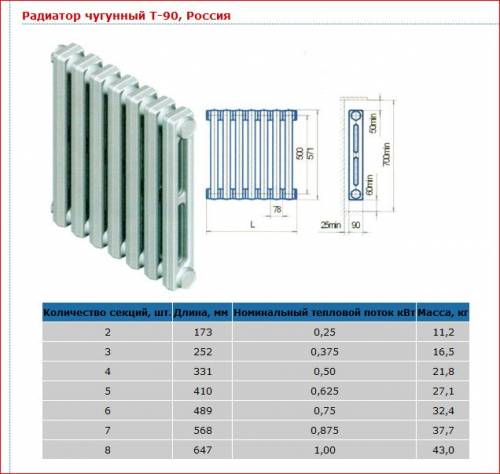
The photo shows an approximate heat transfer of cast iron.
In the room, heating devices are placed at outer wall under the window opening. As a result, the heat radiated by the device is distributed optimally. Cold air coming from the windows is blocked by the heated stream going up from the radiator.
Cast iron batteries
Cast iron counterparts have the following advantages:
- have a long service life;
- have a high level of strength;
- they are resistant to corrosion damage;
- excellent for use in communal systems operating on low-quality heating medium.
- now manufacturers make cast iron batteries (their price is higher than that of conventional counterparts), which have an improved appearance due to the use of new technologies for casting their bodies.
Disadvantages of products: large mass and thermal inertia.
The lower table reads how many kW are in a cast iron radiator, based on its model.
Note!
To heat a room with an area of \u200b\u200b15 m², the power, that is, kW of a cast-iron radiator, must be at least 1.5. In other words, the battery should consist of 10-12 sections.
Aluminum radiators
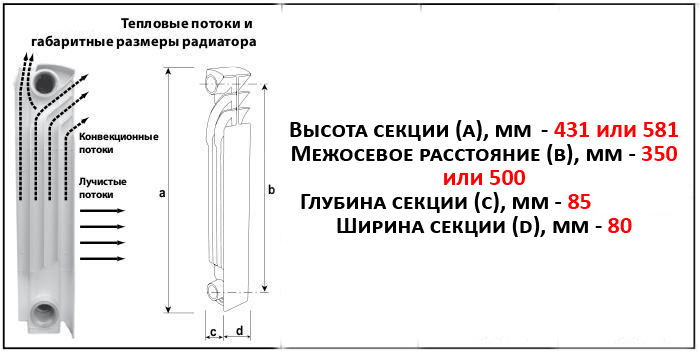
Aluminum products have a higher heat output than cast iron counterparts. When asked how many kW is in one section of an aluminum radiator, experts answer that it reaches 0.185-0.2 kW. As a result, 9-10 sections of aluminum sections will be enough for the normative level of heating a fifteen-meter room.
The advantages of such devices:
- a light weight;
- aesthetic design;
- high level of heat transfer;
- the temperature can be controlled with your own hands using valves.
But aluminum products do not have the same strength as cast iron counterparts, for example, a 2 kW oil cooler. Therefore, they are sensitive to surges in operating pressure in the system, hydraulic shocks, unnecessarily high temperature heat carrier.
Note!
When water has a high pH (acidity) level, aluminum gives off a lot of hydrogen.
This negatively affects our health.
Proceeding from this, it is desirable to use such devices in a heating system in which it has neutral acidity.
Bimetallic products
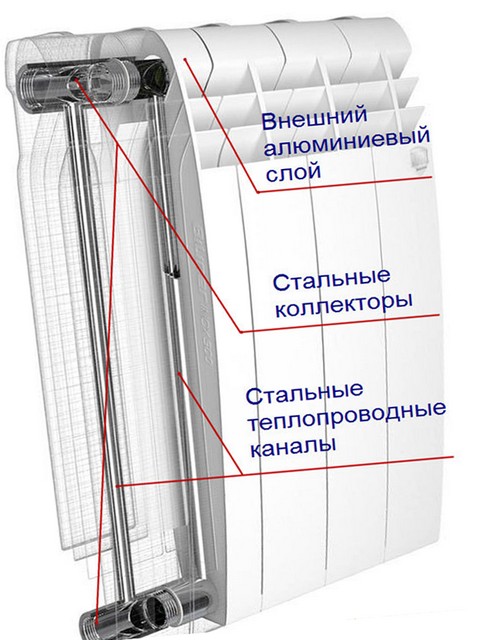
Before figuring out how many kW in 1 section of a bimetallic radiator, it should be noted that such batteries have similar operating parameters with aluminum counterparts. However, they have no inherent disadvantages.
This circumstance determined the design of the devices.
- They consist of copper either steel pipesthrough which the coolant flows.
- The tubes are hidden in an aluminum plate housing. As a result, the water circulating inside does not interact with the aluminum of the case.
- Based on this, the acidic and mechanical characteristics of the heat carrier do not affect the operation and condition of the device in any way.

Thanks to the steel of the pipes, the fixture has high strength. External fins made of aluminum provide increased heat transfer. When trying to find out how many kW is in a steel radiator, keep in mind that bimetal has the highest heat transfer - about 0.2 kW per edge.
Output
Finding out how many kW in 1 section steel radiator or an analogue made of another metal, you can calculate the heat transfer of the purchased product. This will allow you to create an effective heating system in his home.
The video in this article continues to visually inform you on the topic.



